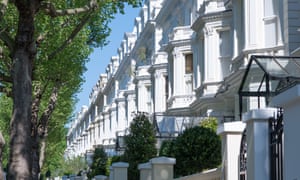House prices fall in London’s luxury postcodes
Oil price, stamp duty and Brexit fears cause drop in areas such as Notting Hill and Hampstead but market rises elsewhere
Data from the estate agency Stirling Ackroyd published on Tuesday showed that the price of homes in 47 out of 272 postcode areas fell over the last quarter, the majority in the city’s most expensive neighbourhoods. Kensington High Street in west London recorded the biggest fall between the first quarter of 2015 and the same period in 2016, dropping to an average of £1.8m. In nearby Notting Hill, average prices were down by 10%, at £1.5m. Other prime postcodes which have seen falls include Hampstead, where prices are down by 9.2% at just over £1m, and South Kensington where they have fallen by 5.8% to £1.9m.
Andrew Bridges, managing director of Stirling Ackroyd, said: “Luxury no longer means profit – or at least you can no longer presume so. London’s hugely diverse property market is undergoing a serious readjustment.”
Bridges said the price fall was due to several factors, “from a low global oil price and China’s economic slowdown, to stamp duty reform and international fears of Brexit”.
However, the agency said the market was rising in other parts of London. Once the prime neighbourhoods were excluded, prices in the capital were up by 2% over the quarter and by 8.2% year-on-year. Across the city it said prices now average £533,000.
Interest in prime London property has been cooling since December 2014 whenchanges to the stamp duty regime made it more expensive to buy homes costing £937,000 or more. Since then, the fear of a mansion tax ahead of 2015’s general election, tax changes on second homes and the forthcoming EU referendum have all dampened demand at the luxury end of the market.
Property firm Lonres said 39% of agents working in London’s most expensive neighbourhoods had seen a fall in European buyers in the last three months, and 63% said their sellers were more willing to negotiate on price than before.
It said prices were up by 0.3% in the first quarter of the year, but this was driven by increases in homes costing less than £1m. It added that almost half of properties sold during the quarter had at least one price reduction before finding a buyer.
On Monday, British Land, one of the UK’s biggest property and development companies, said that the prime residential market had been affected “by both increased supply and recent tax changes and transaction volumes have slowed”.
Delivering its annual results, the company said it had continued to reduce its residential commitment with pre-sales of apartments in two developments, the Hempel and Aldgate Place, and that a third luxury development, Clarges Mayfair, would not be marketed again until it was completed in late 2017. The first 18 flats in the development in central London were sold in 2014 for £210m.
“In the super prime market, there is continued emphasis on the quality of stock, and although London continues to be viewed as attractive, volumes have moderated,” it said. “The mainstream market in London has remained relatively robust with steady demand.”


No comments:
Post a Comment